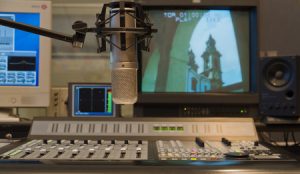Dubbing

What Exactly Is Voice Dubbing?
Voice replacement or dubbing is where a client wants their program/presentation/movie to be translated in a foreign language but instead of through written subtitles, they desire an actual spoken audio track. The process of voice replacement or dubbing is infinitely more time-consuming and difficult than it may appear.
On average, it takes one hour of recording studio time for five minutes of narration (UN-style voice-over) and even more if you want professional lip-sync dubbing. The new audio is recorded by a professional voice actor who not only is fluent in the foreign language but can deliver it with expert rhythm and timing to match the original audio as close as possible. Once the new audio is recorded, it then takes time to clean up the voice track and equalize audio levels, etc.
What Are the Different Types of Voice Dubbing?
English-Under (UN-Style Voice-Over):
Typically, this is done when someone is being interviewed with the assistance of an interpreter. You have probably seen this when watching a news reporter interview an athlete or politician who speaks a foreign language. The speaker will begin speaking in his or her native tongue. After a few seconds, their audio drops slightly and the interpreter will begin narrating. By allowing the original native language to still be audible, it preserves the authenticity, tone, and dramatic effect of the character.
Lip-Sync Dubbing:
A professional voice actor will watch the video as they translate, in an attempt to follow both video and audio cues. That way they can truly act out the scene and maintain the original integrity by paying attention to rhythm, intonation, etc.
How Is Translation Different for Voice-Over and Dubbing?
Approaches to translation will differ depending on the type of program (for example, if the speaker is on-camera or off-camera). A direct verbatim translation is not necessarily the best as it typically becomes expanded and lengthy. Instead, an adaptation of the original narration is preferred. If lip-sync dubbing is desired, the translation may be even more time-consuming as syllable counts must be the same in both languages and words beginning with letters that denote specific mouth movements (like O, A, M, P, S, T, R) are matched as much as possible.
Contact Verbatim Languages for a FREE quote today!
